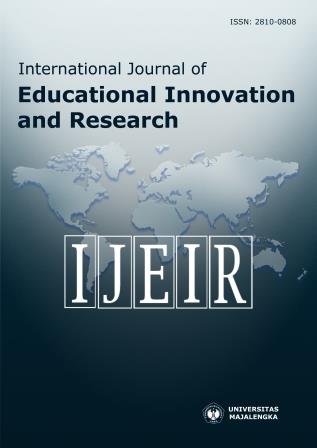Scientific developments in educational innovation research in Indonesia and Malaysia: a scientometric review
DOI:
https://doi.org/10.31949/ijeir.v1i1.2312Abstract
Educational innovation, in its early days, aims to improve educational quality. Active and experiential learning, as well as authentic assessment, are examples of educational innovation. The goal of high-impact practices is to make education more intentional, coherent, developmental, and transformative. This paper examines the evolution of educational innovation research conducted globally based on the Scopus and WoS database. The parameters considered in this study embrace the growth of publications, suubject areas, source titles, countries, institutions, author and authors’ keywords. Another intriguing finding concerns the source title; the Journal of Physics: Conference Series leads 18 publications. In addition, this study indicated that Putra A.B.N.R., of the Universitas Negeri Malang in the Indonesia, is the most active author, having published 6 documents. Other databases, such as PubMed and Google Scholar, can be used to obtain more detailed metadata. Our research contributes to future research trends by providing visualisation and cutting-edge knowledge of educational innovation
Keywords:
Scientific Development, Educational Innovation, Scientometric ReviewDownloads
References
Abdullah, K. H. (2021). Mapping of Marine Safety Publications Using VOSviewer. ASM Science Journal, 16(July), 1–9. https://doi.org/10.32802/asmscj.2021.774
Abdullah, K. H., & Abd Aziz, F. S. (2021). Mapping of Laboratory Safety Research: a Bibliometric Review. Malaysian Journal of Public Health Medicine, 21(1), 303–310. https://doi.org/10.37268/mjphm/vol.21/no.1/art.864
Biasi, B., Deming, D. J., & Moser, P. (2021). Education and innovation. NBER Working Paper Series, MARCH-APRIL, 24–25. https://doi.org/10.1016/b978-0-12-800847-8.00005-3
Chetty, R., Hendren, N., Kline, P., & Saez, E. (2014). Where is the Land of Opportunity? The Geography of Intergenerational Mobility in the United States. The Quarterly Journal of Economics, 129(4), 1553–1623. https://doi.org/10.1093/qje/qju022.Advance
Cohen, D. K., & Ball, D. L. (2006). Educational Innovation and the Problem of Scale *. Scale-up in Education: Ideas in Principle,Vol1, 19–36.
De Graaff, E., & Cowdroy, R. (1997). Theory and practice of educational innovation through introduction of problem-based learning in architecture. International Journal of Engineering Education, 13(3), 166–174.
Deming, D. J., & Walters, C. R. (2017). The Impact of Price Caps and Spending Cuts on U.S. Postsecondary Attainment. NBER Working Paper Series, 1–40. https://www.nber.org/papers/w23736
Dube, S. (2017). The 21st Century Students’ Educational Ict Preferences. International Robotics & Automation Journal, 3(5), 355–357. https://doi.org/10.15406/iratj.2017.03.00069
Efendi, M. Y., Latief, S., & Lien, H. N. (2020). The Educational Innovation Comparison of a Techno teaching Analysis in Primary School between Indonesia and Taiwan. Studies in Learning and Teaching, 1(1), 27–40. https://doi.org/10.46627/silet.v1i1.20
Fidalgo-Blanco, Á., Sein-Echaluce, M. L., & García-Peñalvo, F. J. (2018). Main: Method for applying innovation in education. ACM International Conference Proceeding Series, 806–813. https://doi.org/10.1145/3284179.3284313
Fındıkoğlu, F., & İlhan, D. (2016). Realization of a Desired Future: Innovation in Education. In Universal Journal of Educational Research (Vol. 4, Issue 11, pp. 2574–2580). https://doi.org/10.13189/ujer.2016.041110
Fuad, D. R. S. ., Musa, K., & Yusof, H. (2020). Innovation in education. Journal of Educational Research & Indigenous Studies, 2(1).
Hamayotsu, K. (2002). Islam and nation building in Southeast Asia: Malaysia and Indonesia in comparative perspective. Pacific Affairs, 75(3), 353–376. https://doi.org/10.2307/4127290
Irawaty, & Sumadi, T. (2018). Indonesia and Malaysia : Comparison on The Efforts Of Maintaining National Identities to Higher Education Students. International Conference on University and Intellectual Culture 2018, 1, 415–423.
Jackson, C. K., Johnson, R. C., & Persico, C. (2015). The Effects of School Spending on Educational and Economic Outcomes: Evidence from School Finance Reform. NBER Working Paper Series, 1–81.
Jacobs, C. (2000). The Evaluation of Educational Innovation. Evaluation, 6(3), 261–280. https://pdfs.semanticscholar.org/07d3/c080f7564bb6adb1b479fcca6b8f9b07a1c2.pdf
Li, J., Li, H.-J., & Zhen, L. (2016). Research output of Journal Technovation: A scientometric study. COLLNET Journal of Scientometrics and Information Management, 10(2), 255–272. https://doi.org/10.1080/09737766.2016.1213968
Malakoutikhah, M., Alimohammadlou, M., Rabiei, H., Faghihi, S. A., Kamalinia, M., & Jahangiri, M. (2021). A scientometric study of unsafe behavior through Web of Science during 1991–2020. International Journal of Occupational Safety and Ergonomics. https://doi.org/10.1080/10803548.2021.1953787
Martynov, I., Klima-Frysch, J., & Schoenberger, J. (2020). A scientometric analysis of neuroblastoma research. BMC Cancer, 20(1), 1–10. https://doi.org/10.1186/s12885-020-06974-3
Masami, H. (2021). Society 5.0 and education in Japan. Proceedings of the 4th International Conference on Current Issues in Education (ICCIE 2020).
Moreira, C., Abuzaid, J. N., Elisondo, R. C., & Melgar, M. F. (2020). Educational innovation: perspectives of teachers and students at Universidad nacional de rio cuarto (argentina) and universidad del atlantico (colombia). PANORAMA, 14(26).
Othman, I. (2016). Education System in Malaysia and Indonesia for Human Resource Development. European Journal of Social Sciences Education and Research, 7(1), 117. https://doi.org/10.26417/ejser.v7i1.p117-124
Pabon, C. D. R., Sánchez-Benitez, J., Ruiz-Rosero, J., & Ramirez-Gonzalez, G. (2020). Coffee crop science metric: A review. Coffee Science, 15(1), 1–11. https://doi.org/10.25186/.v15i.1693
Rizal, F., Jalinus, N., Syahril, Sukardi, Zaus, M. A., Wulansari, R. E., & Nabawi, R. A. (2019). Comparison of ICT Using in Learning between Indonesia and Malaysia. Journal of Physics: Conference Series, 1387(1). https://doi.org/10.1088/1742-6596/1387/1/012133
Rodan, G., & Hughes, C. (2014). The Politics of Accountability in Southeast Asia. In Oxford University Press. Oxford University Press.
Ruiz-Rosero, J., Ramirez-Gonzalez, G., Williams, J. M., Liu, H., Khanna, R., & Pisharody, G. (2017). Internet of things: A scientometric review. Symmetry, 9(12). https://doi.org/10.3390/sym9120301
Sein-Echaluce, M. L., Fidalgo-Blanco, Á., & Alves, G. (2017). Technology behaviors in education innovation. Computers in Human Behavior, 72, 596–598. https://doi.org/10.1016/j.chb.2016.11.049
Serdyukov, P. (2017). Innovation in education: what works, what doesn’t, and what to do about it? Journal of Research in Innovative Teaching & Learning, 10(1), 4–33. https://doi.org/10.1108/jrit-10-2016-0007
Tubin, D. (2009). What Can be Expected from Educational Innovation? In Educational Change. https://doi.org/10.13140/2.1.4395.7441
Yangari, M., & Inga, E. (2021). Article educational innovation in the evaluation processes within the flipped and blended learning models. Education Sciences, 11(9). https://doi.org/10.3390/educsci11090487
Yazid, A. P. D. M. N. M. (2014). Colonial Policy and the Impact to the Politico-Economy Stability after Independence: The case of Indonesia under the Dutch and Malaysia under the British. Review of History and Political Science, 2(3&4), 69–84. https://doi.org/10.15640/rhps.v2n3-4a4
Published
How to Cite
Issue
Section
License
Copyright (c) 2022 Davi Sofyan, Khairul Hafezad Abdullah

This work is licensed under a Creative Commons Attribution-ShareAlike 4.0 International License.









